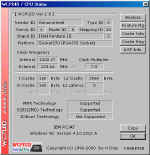| Test System and Scaling
| Intel Pentium3 1000 FCPGA, MSI Slocket,
Golden Orb |
| Soyo SY-6BA+IV i440BX Motherboard,
Highpoint UDMA66 (integrated) |
| Corsair 256MB PC100 SDRAM @ 133MHz CL3 |
| Quantum Fireball AS 20GB 7200rpm Hard
Drive, UDMA100 @ 66 |
| Soundblaster128PCI, Cambridge
Soundworks Microworks |
| IDE CD-ROM and Burner |
| ISA 56k v.90 Hardware Modem |
| Dell Ultrascan V17X 17" Monitor
(1600x1200 true color capable) |
| Windows98SE, DirectX 8.0a |
| 3dfx Voodoo4/5 1.04 WHQL Drivers |
| 3dfx Voodoo3 1.07 WHQL Drivers |
| WickedGL (registered) |
|

|
I used only last official WHQL
Certified driver sets for every card tested. This seemed the best way to not only
eliminate 3rd party driver quirks, but to also allow the cards to perform at maximum
levels using their own driver sets. All tools settings were left at default
except for "3D Filter Quality" and "Alpha Blending," which were set to
"High/Sharper." LOD Bias was left at "0" and all other settings
were left unmodified. The 3dfx Overclocker was
used to disable Vsync for both D3D and Glide/OpenGL.
Although the 1GHz computer system used as the test
platform is certainly not currently state-of-the-art in gaming, I believe it's probably
fairly typical of the average person still using Voodoo cards. The CPU speed is
hardly important when you begin to fill rate limit the video card, and significant CPU
scaling can only occur at lower resolutions. Fill rate is by far the most important
factor when determining scalability, and any video card that reaches fill rate limitations
is going to be the bottleneck in even the most powerful system. This occurs at
different resolutions and color depths for each card, according to each title
played. But a general idea of CPU scaling can still be conducted, even with a 1GHz
system. Since my P3 has a multiplier of 7.5, all I had to do was go into my BIOS and
drop the FSB speed to 100 for a 750MHz system, and down to 66 for 500MHz.
7.5 x 133 = 1000MHz
7.5 x 100 = 750MHz
7.5 x 66 = 500MHz
Using these settings and raising the resolution to
a level where little or no gain is seen at the higher speed, you can quickly come to
certain conclusions about the overall scalability of the video card in question. I
decided to try out the V4 and V3 using these techniques, with Q3A as the benchmark since
it reacts very reliably with changes in CPU speed, FSB setting, and resolution.
Teg conducted around 150 benchmarks testing V5 CPU Scalability, and these
results can be found in this earlier article. But now for the results:
V4 4500 CPU Scalability |
P3 1000/133 |
P3 750/100 |
P3 500/66 |
500-> 1000 |
750-> 1000 |
800x600x16 |
91.3 |
80.0 |
56.8 |
+60% |
+11% |
| 1024x768x16 |
58.2 |
58.0 |
51.0 |
+16% |
+.35% |
| 1280x1024x16 |
34.4 |
34.3 |
34.0 |
+1.2% |
+.30% |
| 800x600x32 |
66.2 |
65.3 |
56.2 |
+16% |
+1.4% |
| 1024x768x32 |
41.0 |
40.9 |
40.9 |
+.25% |
+.25% |

|

|
V4 4500
CPU Scaling Graphs |
V3 3000 CPU Scalability |
P3 1000/133 |
P3 750/100 |
P3 500/66 |
500-> 1000 |
750-> 1000 |
800x600x16 |
70.8 |
69.6 |
56.0 |
+25% |
+1.75% |
| 1024x768x16 |
46.0 |
46.0 |
45.6 |
+1% |
- |
| 1280x1024x16 |
28.2 |
28.2 |
28.2 |
- |
- |
Nothing really
exciting to graph here.  |
The results show fairly conclusively
that both cards start to become fill-rate limited at around 1024x768x16. It's also
pretty obvious by these numbers that the V4 scales very well up to at least 1GHz at
resolutions below 1024x768x16, whereas the V3 maxes out after about 750MHz. There
weren't any significant increases in FPS at the higher resolutions with either card, or
when using 32bit color settings on the V4. Anand reviewed the V4 4500 and found that
it stopped significant CPU scaling altogether at 1.0GHz at 640x480x32 in Q3A. That
review can be found here.
16bit color rendering may scale even further at the lowest resolutions for these
cards, but since most people want to play their games at other than 640x480x16, I don't
find this possibility all that interesting.
These results aren't surprising considering that
the V4 and V3 have nearly identical theoretical fill rate and memory bandwidth. The
V4 may be slightly more efficient than the V3, but after 1024x768x16 res it's all academic
anyways. The V3 did have overall lower numbers since the V4 is better in Q3A, but I
get ahead of myself. On to the benchmarks!
[NEXT]
[Intro
| Test System/Scaling | Benchmarks | Overclocking
| Conclusion] |